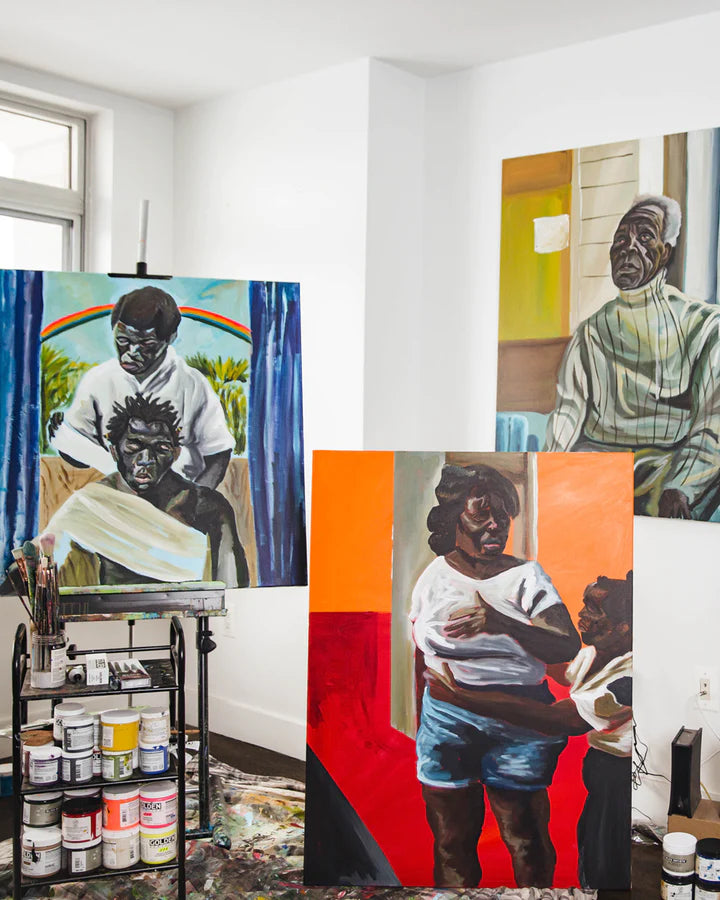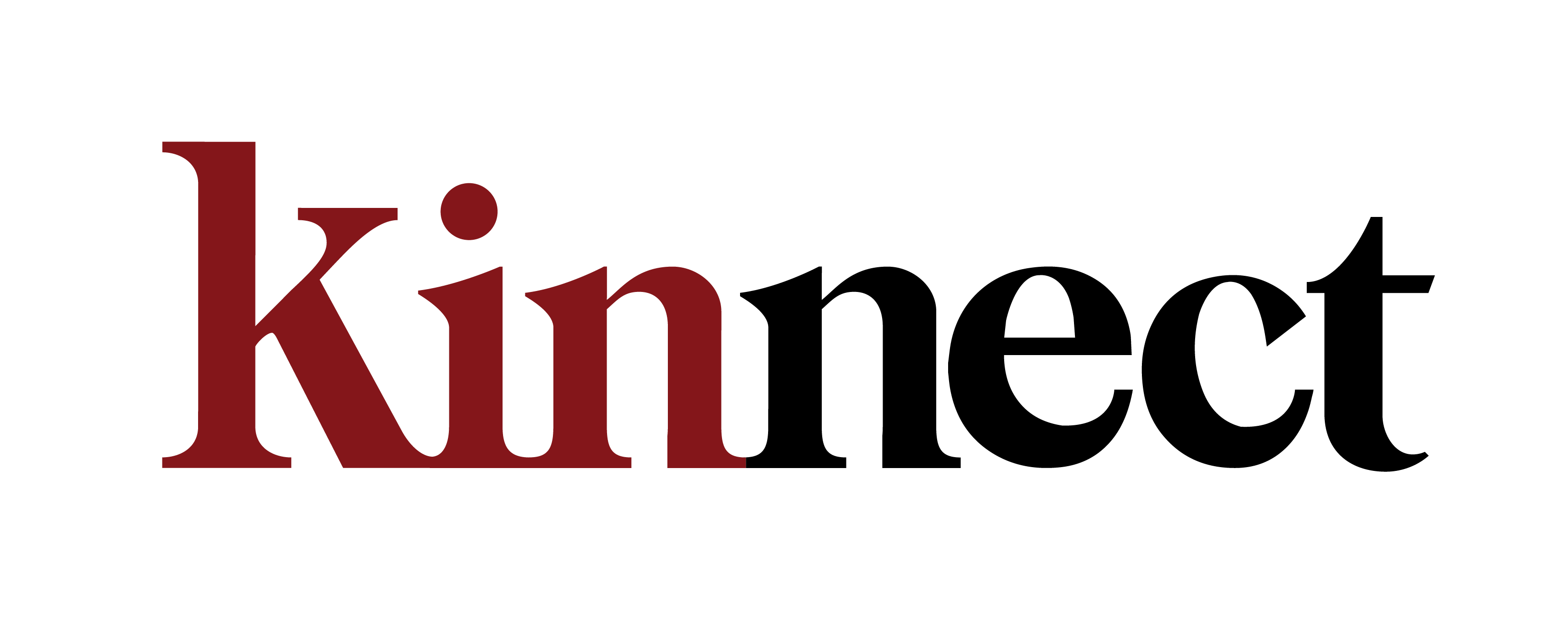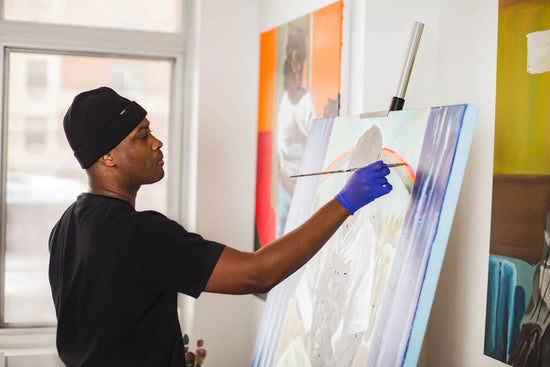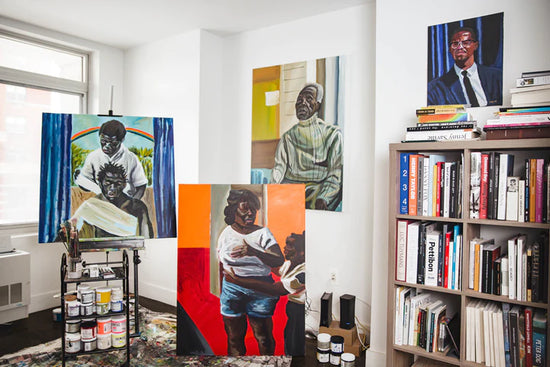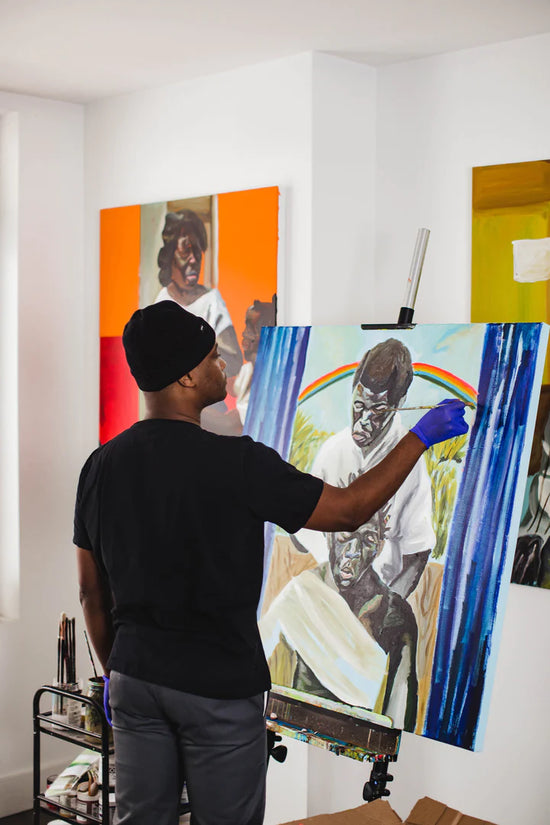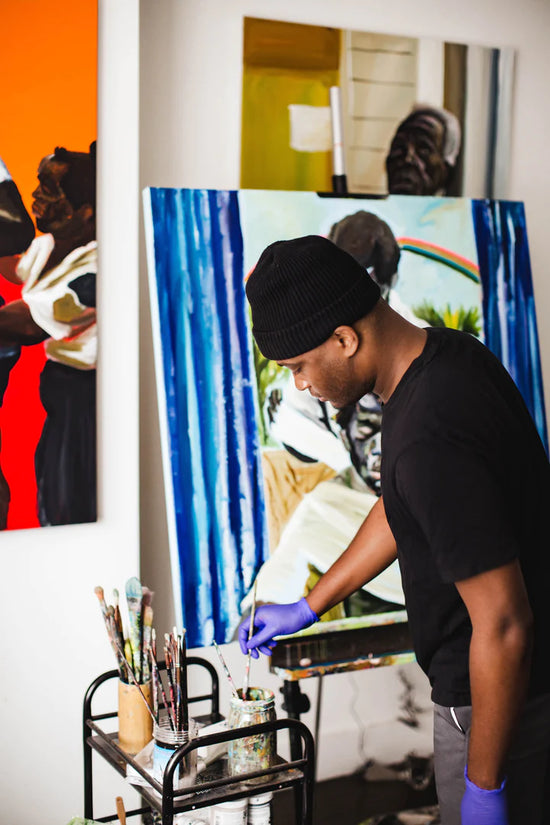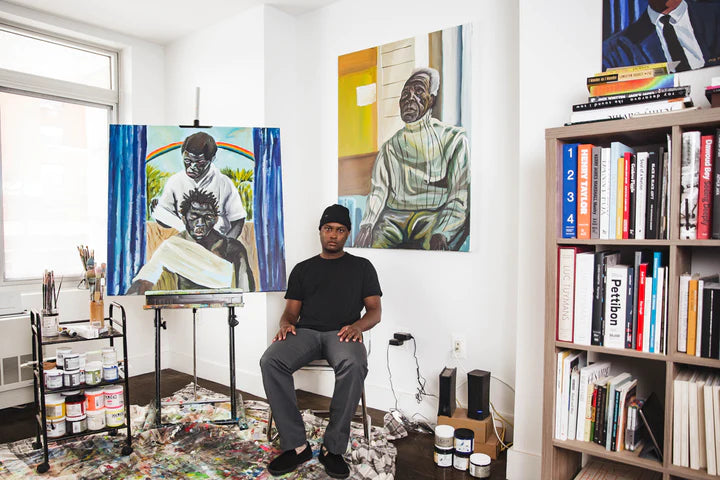
Marcus J. Brutus is a self-taught painter from Maryland whose works explore, “ideas of power through portraiture.” His figurative paintings deftly examine Black American identity and civil right struggles. Brutus, who studied at the St. John’s University in Queens and previously worked in Public Relations, applies his innate ability of storytelling to art.
Drawing inspiration from diverse source materials culled from the realms of fashion, film, music, photography, art, and politics, he fluidly interweaves subtle and overt references to the past and present, the real and imagined to creates vignettes that seem to collapse discrete eras and context.
Greg Betty, Kith's Senior Graphic Designer who worked with the artists to create the apparel capsule, sat down with Marcus Brutus to have a conversation about his process, the significance of responsibility as a Black creative, and more.
Photography by Tayo Kuku
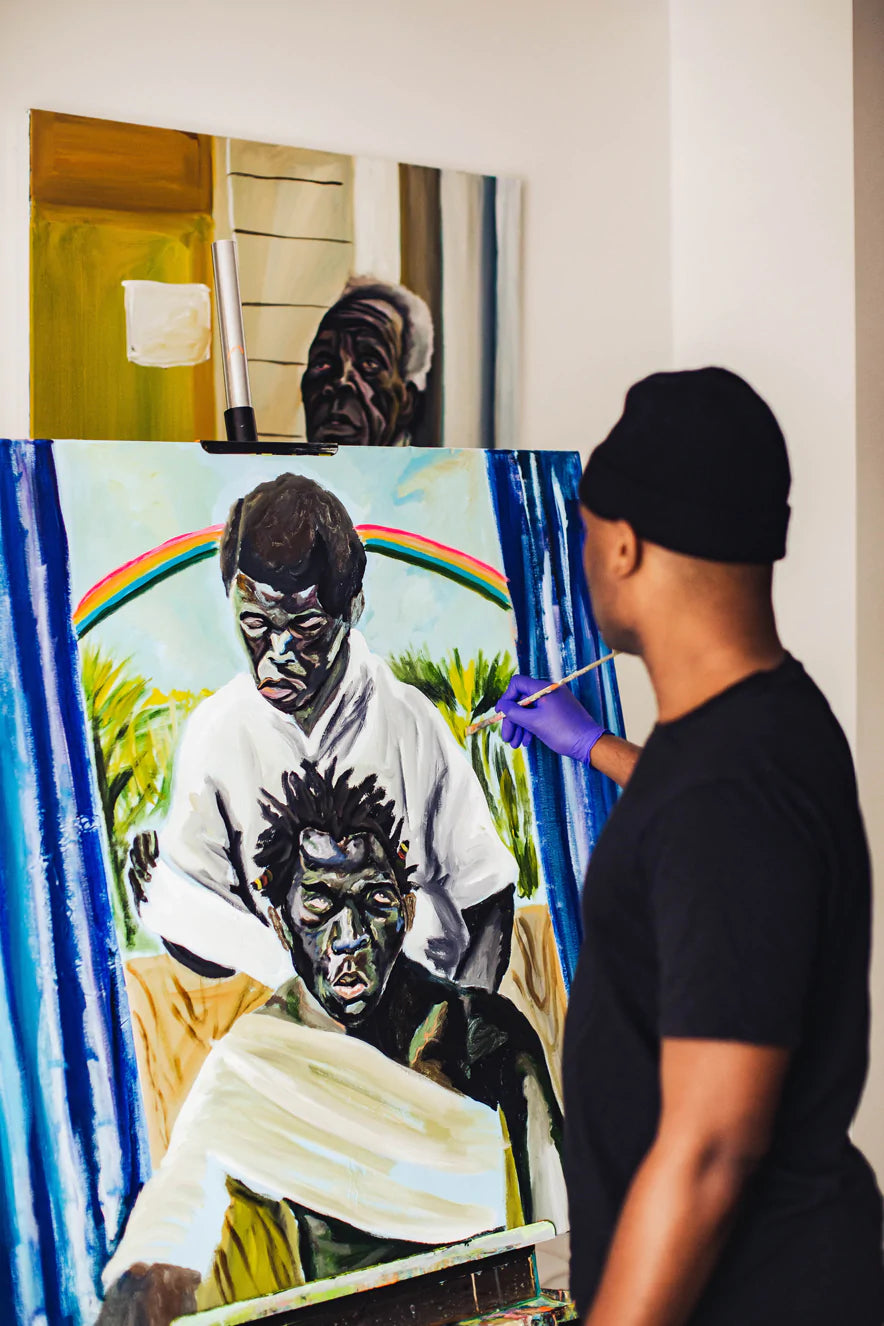
GB: It’s a pleasure doing this interview with you. I've got the chance to hang with you a couple times over the past few months. We have similar friend groups here in New York and it's kind of amazing how small the world is. Can you tell us a little bit about yourself?
MB: I’m originally from Maryland. My parents were born in Haiti and they both moved here in their teens and I grew up in a regular, middle-class suburb, right outside of a major city. I didn't live too far from Washington DC. It wasn't until around age 15 that I started to challenge that upbringing in reality because everything was normal. There’s nothing that jumped out to me when I look back at my childhood. I remember at that age, there was like a two-week period, I was hanging with my dad and one weekend we watched the 1992 Malcolm X by Spike Lee and then the next week, I watched a movie on Patrice Lamumba.
GB: I've watched Malcom X at least five times.
MB: Just watching those two films changed everything for me and I started to change my perspective on things. I always point to that moment as the shift which got me to where I am today.
GB: I also noticed that you don't go by an alias. There's no stage name to use, it's a very strong name, Marcus Brutus. Was this a conscious decision to go by your actual name?
MB: I don't think it was a conscious decision but I’ve just never had a nickname my whole life or like someone gives me a nickname and I completely ignore it. When I got older, as a joke I would tell my parents, “You really gave me a name that's awful for SEO.”
GB: I read that you graduated from St. John’s University with a BS degree in Public Relations and shortly after became a self-taught painter. Those two worlds are drastically different. How did your educational studies help with your career as an artist?
MB: I went to St. John’s because I wanted to live in New York City. l wanted to work closely with creatives because I felt I could never do it myself, so the next best thing would be to work in the industry behind the scenes. That's why I selected public relations. After graduating, I had started working for a PR firm that's no longer around called Black Frame. They represented artists and designers in fashion, architecture and more and that really intrigued me, but once I got there I didn’t find it as fulfilling as I thought it would be. College just helped me learn that I didn’t really want to go the academic route. I always said I was going to graduate but I never liked it. It was a nice experience but no matter what you do, you're going to have to apply yourself to excel, whether you do it while pursuing a degree or do it on your own. So now I just use the same things I would do to prepare for a test to prepare for my art, and that helped me as I pursued a career in painting.
GB: I definitely used college as a discipline, especially in my work because I didn't go to school specifically for design. I don't know how this happened. I just followed my dreams after three years of studying engineering. I just had that 'a-ha' moment and I find it funny that a large number of people in the creative field have that similar epiphanic moment when they just go for it full throttle. Do you remember that exact moment when you told yourself you were going to be a full time artist?
MB: After a year and a half, I was tired of working for a PR firm, so I started looking for jobs and nothing really intrigued me. I started to dig deeper and I told myself if I don't go the creative route, I won't be fulfilled and it’ll just be jumping from job to job. So I just went for it and I ended up moving out of New York and back to Maryland and I lived there for 2-3 years so I could work on my craft. I didn't know where this was going to take me but I just wanted to go at it and do it.
GB: I know that you come from a Caribbean household so that stress and importance of education is always being drilled into us from a young age. Did you get pushback from your parents about choosing a creative endeavor instead of the traditional educational route such as being a doctor?
MB: Not really because I've always been a bit clever on how I introduce things to people. It’s the reason why I like to reference books and films, things that reaffirm your point and perspective so I knew that I had to go and complete my degree, no matter what. You do that and get your parents to chill for a little. While I was painting, I was working as well and they began to notice that I was always spending a lot of time and effort into this thing. I remember there was a point after two years of pushing and developing things where I hit a roadblock and thought, “Man this isn't going anywhere, maybe I should go into some master's program. Not in Fine Arts but something else.” I was applying softly and I didn't want to do it but I was doing it regardless and both my parents are super academic so when I told them they just asked why. Once they kind of caught on, I think that's when they started trusting that I was making the right decision.
GB: It all depends on how you answer the “Why?” question because I definitely got hit with a couple of those early in my career before I got to this point. But you stuck it out which is the amazing part and since then you’ve had three solo shows with Harper's Books. You’ve been in a number of group shows and you also released a book, right? All within 2-3 years which is amazing. Can you tell us a little bit about those opportunities?
MB: It all began with Jen Guidi randomly. I was at home and she had her sister reach out saying that she liked my work and she wanted to see if I had any for sale. It took me a while to even consider selling work for some reason but something about this called out to me. She bought a couple paintings and she was sharing them online. Harper had caught wind of it and he reached out to her to connect with me, so I passed along my information and then immediately we started working together. This was around May and then there was a group show in July, which is when he asked me to do a solo exhibition in New York in September. Things just started happening from there. Working with Harper has been great, regardless of the direction I take with it, he’s very supportive. It was actually his idea to put out the book so it's always been a collaborative effort.
GB: I'm not sure if I first discovered you on the explore page or through an art forum but I do remember being completely amazed by your work. Not only is your work cohesive in terms of the tone and feeling, but as a Black man, your work is very relatable. Whether you're painting a self-portrait or a specific moment in Black history, they all seem to be excerpts from the same ongoing novel of life in Black America. When did you find your particular style or how did this style find you?
MB: I think it all clicked in 2015 for me. Initially when I started painting, it wasn't Black figures and I felt like the work just didn't connect with me. Once I dug deep with it, I told myself this is what the focus of my work should be and that's when things started to make sense. Naturally I'm just drawn to Black history throughout the world and Black stories and just the culture of Black people. Beyond the physical intellectualism of Black people. It all interested me and it effortlessly makes itself in any work that I create. It's always referenced because that's primarily what I read about, documentaries I watch, or the content I engage with.
GB: I noticed that you put a lot of focus into color. Why is color so important to you especially when portraying images of Black people?
MB: It initially started with bright yellows, greens and oranges. They gave me a very contemporary feel. Like if you're driving past traffic signs or construction sites - the vest, the cone, etc. Anything recurring that finds its way into everyday life. So it just gave a feeling of the now and then having that hop in the work is what pushed me to try other fluorescent colors. I felt free rein to reference any story or subject matter because there is a visual element to work with and then there is the messaging that's embedded in it. I have a painting that references the equal landing, where there was a mass slave suicide but there’s a women in a bathing suit that shows a rainbow. I wrote Legacy of Ibo Landing on the painting which gives you a market for future reference. But as you're looking at the painting, if you don't have any sort of reference to understand what I’m talking about, you’re simply looking at a beautiful painting. Like Lauryn Hill’s That Thing, I remember when I was younger and just thinking it’s a cool song but what is the messaging behind it and what is That Thing? It's something like that where it has to feel attractive and then it gives the work more life to allow for storytelling and messaging.
GB: I like that a lot. I want to talk about your collaborative project for a second. Each artist was asked to reinterpret the Kith classic logo in their own stylistic way. Can you talk about the portrait you selected to be intertwined with the Kith classic logo and what that means to you?
MB: It's a portrait of three figures - a guy avoiding two girls in a forest. I prefer to use a painting like that because it isn't filled with a bunch of references. I always like to balance my work, I dont always want things attached to it. Sometimes I just want it to be visually striking on its own.
GB: Then you form those opinions and knowledge and transform it into beautiful bodies of work.
MB: Sometimes. I like to collect images and reference that or the setting or a base color. A lot of times when I start working on it, stories just come to my head. If I feel lost or stuck while painting, my way to get direction is just think what if I could add something referenced from something else. It's never just an idea and I start painting. It’s more of a visual narrative and it builds itself within the work.
GB: I think it's important sometimes as a creative to step back. You can start the process and something else might come to mind.
MB: I just treat everything like an ongoing process. There are many times when I want to sketch before I start painting but when the idea is so strong, I cant even start with the sketch. I have to put something down on the canvas. I don't want to limit any part of the process, I can't operate in a mechanical manner.
GB: Lastly, I want to ask what can the world expect from Marcus Brutus in the future?
MB: There are more shows coming up. I have a group show in Florence in February and a couple other shows in the following months. Aside from that, more experimentation and different mediums.
GB: Do you want to get into anything else like sculpture or furniture?
MB: I don't want to get into anything else unless it makes sense for me. The more that I paint the more I realize there's so much more that I can do. I like to look back at the work I’ve created and think there’s way more that I can be doing. At the moment it's not transferring into other mediums, there's a long way to go for me with painting. More stories, more colors and more life.
GB: I love that and the authenticity is the most impactful part about you and challenging that personal authenticity into your work. Thanks for spending this time with us, it's been an amazing interview.
MB: Thank you.
